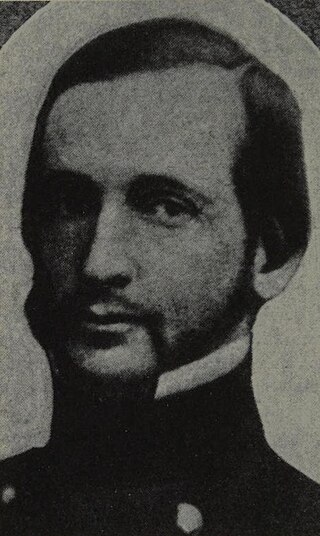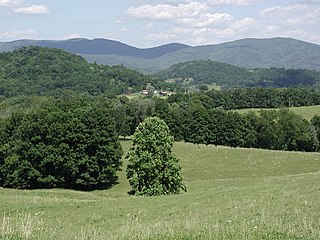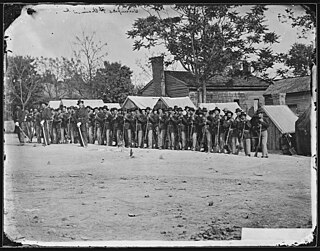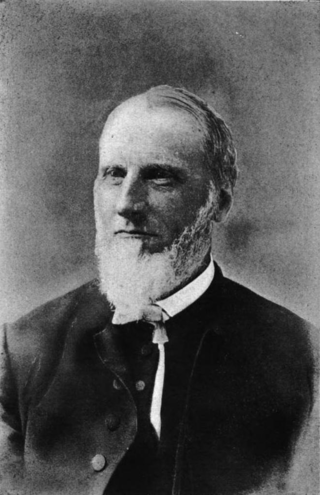
George Brinton McClellan was an American soldier, Civil War Union general, civil engineer, railroad executive, and politician who served as the 24th governor of New Jersey. A graduate of West Point, McClellan served with distinction during the Mexican–American War (1846–1848), and later left the Army to serve as an executive and engineer on railroads until the outbreak of the American Civil War (1861–1865). Early in the conflict, McClellan was appointed to the rank of major general and played an important role in raising a well-trained and disciplined army, which would become the Army of the Potomac in the Eastern Theater; he served a brief period as Commanding General of the United States Army.

The First Battle of Bull Run, called the Battle of First Manassas by Confederate forces, was the first major battle of the American Civil War. The battle was fought on July 21, 1861, in Prince William County, Virginia, just north of the city of Manassas and about thirty miles west-southwest of Washington, D.C. The Union Army was slow in positioning themselves, allowing Confederate reinforcements time to arrive by rail. Each side had about 18,000 poorly trained and poorly led troops. The battle was a Confederate victory and was followed by a disorganized post-battle retreat of the Union forces.

The Battle of Philippi formed part of the Western Virginia Campaign of the American Civil War and was fought in and around Philippi, Virginia, on June 3, 1861. A Union victory, it was the first organized land action of the war, though generally viewed as a skirmish rather than a battle. However, the Northern press celebrated it as an epic triumph and this encouraged Congress to call for the drive on Richmond that ended with the Union defeat at First Bull Run in July. It brought overnight fame to Maj. Gen. George B. McClellan and was notable for the first battlefield amputations. As the first of a series of victories that pushed Confederate forces out of northwest Virginia, it strengthened the Union government in exile that would soon create the new state of West Virginia.
The following is a list of engagements that took place in 1861 during the American Civil War.

The Battle of Cheat Mountain, also known as the Battle of Cheat Summit Fort, took place from September 12 to 15, 1861, in Pocahontas County and Randolph County, Virginia as part of the Western Virginia Campaign during the American Civil War. It was the first battle of the Civil War in which Robert E. Lee led troops into combat. During the battle, Lee attempted to surround the Union garrison atop Cheat Mountain, but the attack was never launched, due to false information from prisoners and poor communications among the various Confederate commands.

The First Battle of Kernstown was fought on March 23, 1862, in Frederick County and Winchester, Virginia, the opening battle of Confederate Maj. Gen. Thomas J. "Stonewall" Jackson's campaign through the Shenandoah Valley during the American Civil War.

The Battle of Cedar Mountain, also known as Slaughter's Mountain or Cedar Run, took place on August 9, 1862, in Culpeper County, Virginia, as part of the American Civil War. Union forces under Maj. Gen. Nathaniel P. Banks attacked Confederate forces under Maj. Gen. Thomas J. "Stonewall" Jackson near Cedar Mountain as the Confederates marched on Culpeper Court House to forestall a Union advance into central Virginia. After nearly being driven from the field in the early part of the battle, a Confederate counterattack broke the Union lines resulting in a Confederate victory. The battle was the first combat of the Northern Virginia campaign.

Samuel Wylie Crawford was a United States Army surgeon and a Union general in the American Civil War.

The eastern theater of the American Civil War consisted of the major military and naval operations in the states of Virginia, West Virginia, Maryland, and Pennsylvania, the District of Columbia, and the coastal fortifications and seaports of North Carolina.

Robert Huston Milroy was a lawyer, judge, and a Union Army general in the American Civil War, most noted for his defeat at the Second Battle of Winchester in 1863.

Robert Selden Garnett was a career military officer, serving in the United States Army until the American Civil War, when he became a Confederate States Army brigadier general. He was the first general officer killed in the Civil War.

Laurel Mountain, also called Laurel Hill, is a long ridge in north-central West Virginia, US. Along with Rich Mountain to the south, it is considered to be the westernmost ridge of the Allegheny Mountains and the boundary between the Alleghenies and the Allegheny Plateau.

The 9th Indiana Volunteer Infantry Regiment was a volunteer infantry regiment in the Union Army during the American Civil War. It was organized on April 22, 1861, for three-months' service in Indianapolis. After being reorganized for three years' service in late August and early September 1861, the 9th took part in many major battles, including Shiloh, Stones River, Chickamauga, Lookout Mountain, Missionary Ridge, Kennesaw Mountain and the Siege of Atlanta.

The Battle of Corrick's Ford took place on July 13, 1861, on the Cheat River in western Virginia as part of the Operations in Western Virginia Campaign during the American Civil War. By later standards the battle was a minor skirmish. Often considered a final part of the Battle of Rich Mountain, it was the end of a series of battles between the forces of Union Maj. Gen. George B. McClellan and Confederate Brig. Gen. Robert S. Garnett.

John Pegram was a career soldier from Virginia who served as an officer in the United States Army and then as a brigadier general in the Confederate Army during the American Civil War. He became the first former U.S. Army officer to be captured in Confederate service in 1861 and was killed in action near the end of the war.

Thomas Armstrong Morris was an American railroad executive and civil engineer from Kentucky and a soldier, serving as a brigadier general of the Indiana Militia in service to the Union during the early months of the American Civil War. During the Western Virginia Campaign in 1861, he played an important role in leading regiments from West Virginia, Indiana, and Ohio in clearing the Confederate army from western Virginia during the Battle of Philippi, a move that helped bolster pro-Union sentiment and contributed to the creation of the separate state of West Virginia. Morris was also instrumental in the planning and construction of the postbellum Indiana State House.
The Army of the Northwest was a Confederate army early in the American Civil War.
The western Virginia campaign, also known as operations in western Virginia or the Rich Mountain campaign, occurred from May to December 1861 during the American Civil War. Union forces under Major General George B. McClellan invaded the western portion of Virginia to prevent Confederate occupation; this area later became the state of West Virginia. West Virginians on both sides would fight in the campaign while a Unionist convention in Wheeling would appoint their choice for a Unionist governor for Virginia, Francis H. Pierpont, and promote the creation of a new state in western Virginia. Large scale Confederate forces would gradually abandon the region, leaving it to small local brigades to maintain hold on southern and eastern sections for much of the war.

Julius Adolphus De Lagnel, was a Confederate States Army officer, who was appointed and confirmed as a brigadier general, during the American Civil War, but who declined the appointment. He was second in command to Brigadier General Josiah Gorgas in the Confederate Ordnance Bureau and at times was an inspector of arsenals. Before the war, he served in the United States Army from March 8, 1847 until May 17, 1861. After the war, he was engaged in Pacific steamship service.

John Mayo Pleasants Atkinson was the tenth President of Hampden–Sydney College from 1857 to 1883. He was the first alumnus of the College to be named its president and is the longest tenured president to date.






























